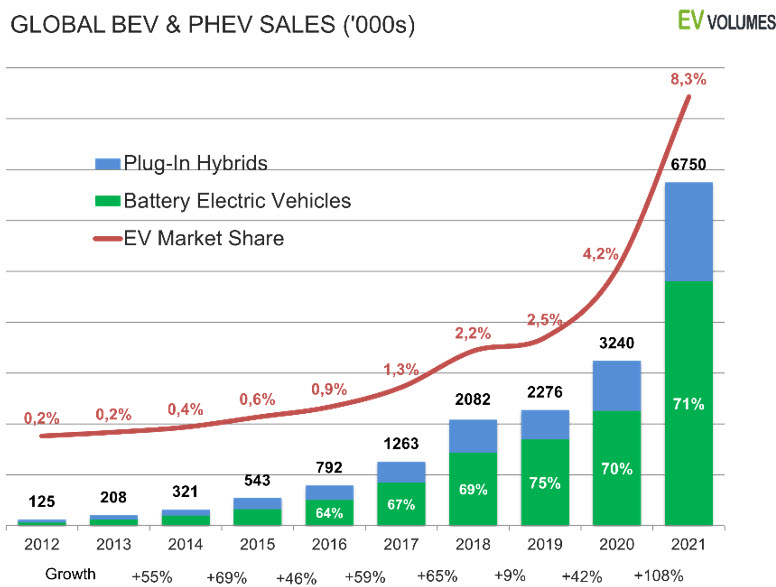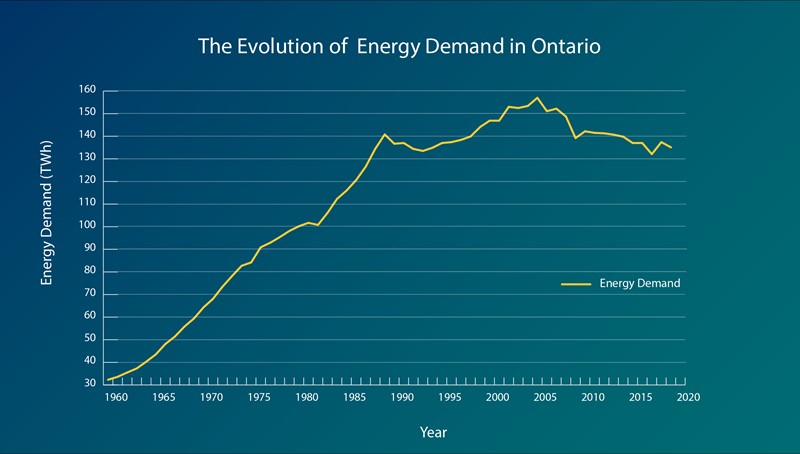The spread of new technologies often follows a similar pattern. Their uptake is slow at first as consumers assimilate the concept and as the early bugs are corrected. Eventually, the technology moves from niche to mass market and sales take off. As can be seen in the chart, electric vehicles (EVs) may be at that point where their sales start increasing dramatically. This global phenomenon includes Canada where sales were 73,600 EVs in 2021 and grew 89% in Ontario.

Reasons for the growth in EV sales are many including improved range, rising gas prices (especially now), lower purchase prices, more EV options, more severe climate change effects, increased number of charging stations and greater awareness.
If EV sales do take-off, this will have an impact on the electricity industry in Ontario. Transportation accounts for 39% of all energy usage in Ontario while the use of electricity accounts for 23%. This means that if all the transportation in Ontario switched to some form of electric vehicle, the electricity grid would have to be almost three times (2.7) as large. This would be a monumental expansion and, given the challenges Ontario has with the cost of electricity today, one may assume the impact on the cost of electricity will be enormous.
I do not believe that will be the case and I believe the electrical industry will be well equipped to handle this.
First, this is a change that will take time. EVs made up only 3.3% of new car sales in Ontario in 2021. The still have a way to go before they are the dominant form of transport. While most auto manufacturers are investing heavily in EVs, even the most aggressive are not calling for their fleets to be 100% EV until 2035 or thereabouts. The average auto lifespan in Canada is around 13 years so it will be many decades until all internal combustion engine vehicles are replaced.
Second, EVs can be charged at any time. Their batteries store the electricity until it is needed. One of the challenges of the current electricity system is that electricity must be generated as it is needed. There is very little storage. This means we must have the generation needed to meet the peak demand. In 2021, the peak demand in Ontario was 22,986 MW. Meanwhile, the average hourly demand in Ontario in 2021 was 15,091; only 66% of the peak. There is spare electricity generation capacity in Ontario that is not being used.
Third, we are not using as much electricity as we did a decade and a half ago. Our total usage then was 157 TWh and in 2021 it was 134 TWh; a decline of 15%. This can be seen on the adjacent graph. Some of this drop in demand is illusionary as these measurements do not capture all the small power installations that are directly connected to local distribution systems (like rooftop solar) but it does demonstrate that we once had higher electricity usage so can again.

Finally, as can also be seen on the graph, usage of electricity grew from just over 30 TWh in 1960 to around 140 TWh in 1987; an increase of 467% in 27 years. We have met the fast-growing demand for generation before so can do it again.
I am not arguing that this will be easy. There will be plenty of challenges as we determine how to obtain this additional electricity generation to power the use of electric vehicles. But it is definitely doable.
Hello:
I came across your article while looking for EV load forecasts for Ontario. I do various analysis and public talks in this area.
I believe your numbers for electricity for EVs are much too much large. This is possible because whoever generated the numbers did not account for the vast difference in efficiency of gasoline and diesel powered vehicles compared to gasoline. If you would like a more complete explanation, please email me back.
I’m a retired professor and P.Eng. just trying to get solid data out there in the EV sphere.
Maybe create an extra time slot for EV,s to be programmed for a charging time that would work for the supplier and the consumer at a discount rate. This can easily be done with time of day set up.